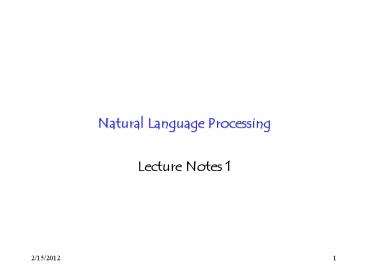Natural Language Processing - PowerPoint PPT Presentation
Title:
Natural Language Processing
Description:
Machine translation. 8/21/09. 9. Big Applications ... We'll touch on Machine Translation, but it needs its own course. 8/21/09. 15. Chapter 1 ... – PowerPoint PPT presentation
Number of Views:45
Avg rating:3.0/5.0
Title: Natural Language Processing
1
Natural Language Processing
- Lecture Notes 1
2
Today
- Administration and Syllabus
- course web page
- Introduction
3
Natural Language Processing
- What is it?
- What goes into getting computers to perform
useful and interesting tasks involving human
languages. - Secondarily insights that such computational
work give us into human languages and human
processing of language.
4
Natural Language Processing
- Foundations are in computer science (AI, theory,
algorithms,) linguistics mathematics logic
and statistics and psychology
5
Why Should You Care?
- Two trends
- An enormous amount of knowledge is now available
in machine readable form as natural language text - Conversational agents are becoming an important
form of human-computer communication
6
Knowledge of Language
- Words (words and their composition)
- Syntax (structure of sentences)
- Semantics (explicit meaning of sentence)
- Discourse and pragmatics (implicit and contextual
meaning)
7
Small Applications
- Line breakers
- Hyphenators
- Spelling correctors
- Optical Character Recognition software
- Grammar and style checkers
8
Big Applications
- Question answering
- Conversational agents
- Text summarization
- Machine translation
9
Note
- NLP, as in many areas of AI
- Were often dealing with ill-defined problems
- We dont often come up with perfect
solutions/algorithms - We cant let either of those facts get in our way
10
Course Material
- Well be intermingling discussions of
- Linguistic topics
- Syntax and meaning representations
- Computational techniques
- Context-free grammars
- Applications
- Translation and QA systems
11
Chapter 1
- Knowledge of language
- Ambiguity
- Models and algorithms
- History
12
Knowledge of Language
- Phonetics and phonology speech sounds, their
production, and the rule systems that govern
their use - Morphology words and their composition from more
basic units - Cat, cats (inflectional morphology)
- Child, children
- Friend, friendly (derivational morphology)
13
Knowledge of Language
- Syntax the structuring of words into legal
larger phrases and sentences
14
Semantics
- The meaning of words and phrases
- Lexical semantics the study of the meanings of
words - Compositional semantics how to combine word
meanings - Word-sense disambiguation
- River bank vs. financial bank
15
Pragmatics
- Indirect speech acts
- Do you have a stapler?
- Presupposition
- Have you stopped beating your wife?
- Deixis and point of view
- Zoe was angry at Joe. Where was he?
- Implicature
- -Yes, there are 3 flights to Boston. In fact,
there are 4. - The general was assassinated. In fact, he
isnt dead.
16
Discourse
- Utterance interpretation in the context of the
text or dialog - Sue took the trip to New York. She had a great
time there. - Sue/she
- New York/there
- took/had (time)
17
Ambiguity
- Almost all of the non-trivial tasks performed by
NLP systems are ambiguity resolution tasks - There is ambiguity at all levels of language
18
Ambiguity
- I saw the woman with the telescope
- Syntactically ambiguous
- I saw (NP the woman with the telescope)
- I saw (NP the woman) (PP with the telescope)
19
I made her duck
- I cooked waterfowl for her
- I cooked waterfowl belonging to her
- I create the duck she owns
- I caused her to lower her head quickly
- Part of speech tagging is duck a noun or verb?
- Parsing syntactic structure is her part of
the duck NP? - Word-sense disambiguation (lexical semantics)
does make mean create, lower head, or cook?
20
Dealing with Ambiguity
- Two approaches
- Tightly coupled interaction among processing
levels knowledge from other levels can help
decide among choices at ambiguous levels. - Pipeline processing
- Most NLP systems are probabilistic they make
the most likely choices
21
Models and Algorithms
- Models (as we are using the term here)
- Formalisms to represent linguistic knowledge
- Algorithms
- Used to manipulate the representations and
produce the desired behavior - choosing among possibilities and combining pieces
22
Models
- State Machines finite state automata, finite
state transducers - Formal rule systems context free grammars
- Logical formalisms first-order predicate
calculus higher-order logics - Models of uncertainty Bayesian probability theory
23
Algorithms
- Many of the algorithms that well study will turn
out to be transducers algorithms that take one
kind of structure as input and output another.
24
Algorithms
- In particular..
- State-space search
- To manage the problem of making choices during
processing when we lack the information needed to
make the right choice - Dynamic programming
- To avoid having to redo work during the course of
a state-space search - Machine Learning (classifiers, EM, etc)
25
State Space Search
- States represent pairings of partially processed
inputs with partially constructed answers - E.g. sentence partial parse tree
- Goal is to arrive at the right/best structure
after having processed all the input. - E.g. the best parse tree spanning the sentence
- As with most interesting AI problems the spaces
are too large and the criteria for bestness are
difficult to encode (so heuristics, probabilities)
26
Dynamic Programming
- Dont do the same work over and over.
- Avoid this by building and making use of
solutions to sub-problems that must be invariant
across all parts of the space.































